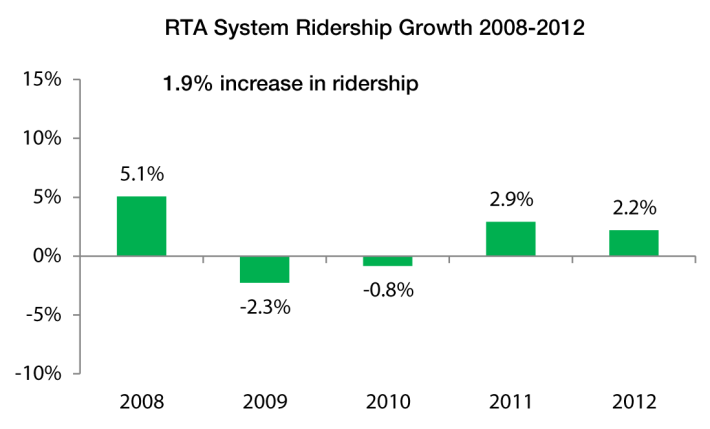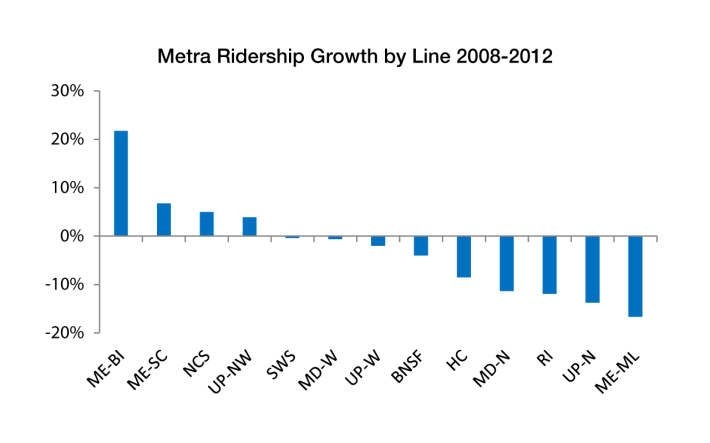
In a new report [PDF], the Regional Transportation Authority blames weak ridership growth from 2008 to 2012 primarily on economic factors, glossing over the impact of fare hikes and service cuts.
During the period covered by the report, CTA ridership grew 3.7 percent, while Metra ridership and Pace ridership each shrank by 6.3 percent. With every CTA rail line experiencing growth, canceling out the commuter rail and bus declines, overall RTA ridership increased 1.9 percent. Still, CTA's ridership growth lagged behind rapid transit systems in New York, San Francisco, Boston, and Philadelphia, but not DC, according to the American Public Transit Association [2008, 2012]. Metra's ridership change, meanwhile, was worse than other big-city commuter rail systems except for Boston and the Long Island Rail Road, according to APTA.
While admitting that "the recession negatively impact[ed] transit operations" and "forced Chicago Transit Authority, Metra, and Pace to consider fare increases and service cuts," the RTA report largely skirts the issue of how shrinking service and rising fares affected ridership, focusing mainly on other factors.
The service boards did more more than "consider" fare increases and service cuts. CTA and Pace raised fares in 2009, and Metra raised them three times, in 2008, 2010, and then again, significantly, in 2012. And in 2010, CTA and Pace cut service, including nine of CTA's express bus routes. These fare increases and service cuts, combined with small job losses, contributed to a decrease in ridership across all three agencies in 2009 and 2010. The RTA report does point the finger at Metra's 25 percent fare increase in 2012 and the state eliminating the Seniors Ride Free program in late 2011, as well as disruptions caused by the NATO summit in May 2012.
The report goes on to list several other reasons why Metra ridership decreased 1.7 percent in 2012 – like extreme summer heat, changes in the Chicago festival calendar, and Wacker Drive construction limiting access to West Loop terminals. But how much of an impact did these factors really have? Would Metra ridership have year-over-year growth, like CTA rail, if not for these reasons?

The RTA argues that economic factors explain declines in ridership in 2009 and 2010, as well as rebounding ridership in 2011 and 2012. This may be true, but the report is rife with data that are either irrelevant, inconsistent, or unconvincing. It tries to make a point by showing regional unemployment for an area larger than what RTA service covers, for instance. Graphs and charts that purport to show a link between the strength of the economy and transit use don't align with actual ridership patterns. In other words, the RTA fails to connect the dots.
The relationship between fares, service levels, and ridership, meanwhile, is well known. For every increase in fare, the corresponding decrease in ridership can be predicted. But for some reason, RTA's report refrains from making a strong case that service changes and fares have affected ridership.
Much more useful information came out of the Metropolitan Planning Council's research showing that decreased spending on Chicagoland transit over the past 20 years has hindered economic growth. The MPC report, for instance, showed that Metra is overly focused on work commutes (peak hour) to downtown, which are a falling portion of regional trips.
The RTA's focus on economic factors might have made sense if service and fares had held steady. But with service reduced left and right while fares jump every year or two, these factors deserve a closer look. In future reports the RTA shouldn't shy away from studying how service provision and fares change ridership. Without that kind of analysis, how will Chicago ever muster the will to enact policies that strengthen transit and grow ridership?





